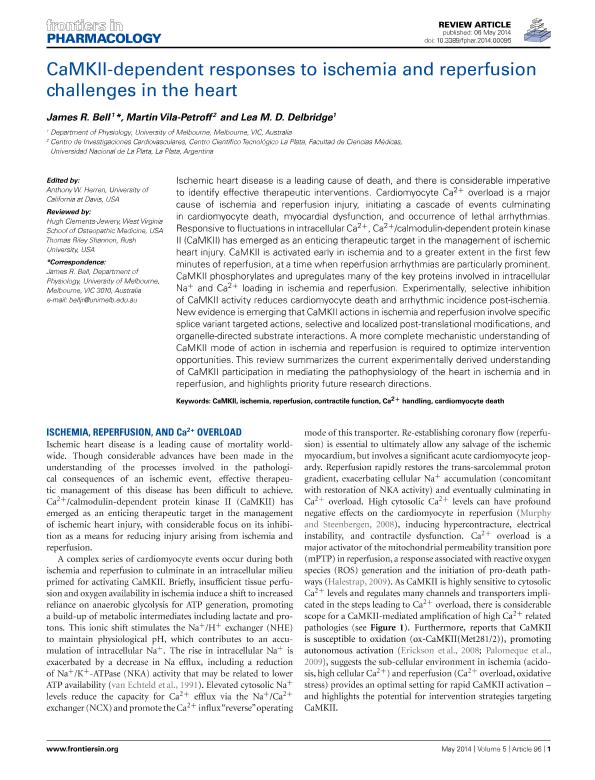Mostrar el registro sencillo del ítem
dc.contributor.author
Bell, James R.
dc.contributor.author
Vila Petroff, Martin Gerarde

dc.contributor.author
Delbridge, Lea M. D.
dc.date.available
2017-01-25T20:16:54Z
dc.date.issued
2014-05
dc.identifier.citation
Bell, James R.; Vila Petroff, Martin Gerarde; Delbridge, Lea M. D.; CaMKII-dependent responses to ischemia and reperfusion challenges in the heart; Frontiers; Frontiers in Pharmacology; 5; 5-2014; 1-7; 96
dc.identifier.uri
http://hdl.handle.net/11336/11937
dc.description.abstract
Ischemic heart disease is a leading cause of death, and there is considerable imperative to identify effective therapeutic interventions. Cardiomyocyte Ca2+ overload is a major cause of ischemia and reperfusion injury, initiating a cascade of events culminating in cardiomyocyte death, myocardial dysfunction, and occurrence of lethal arrhythmias. Responsive to fluctuations in intracellular Ca2+, Ca2+/calmodulin-dependent protein kinase II (CaMKII) has emerged as an enticing therapeutic target in the management of ischemic heart injury. CaMKII is activated early in ischemia and to a greater extent in the first few minutes of reperfusion, at a time when reperfusion arrhythmias are particularly prominent. CaMKII phosphorylates and upregulates many of the key proteins involved in intracellular Na+ and Ca2+ loading in ischemia and reperfusion. Experimentally, selective inhibition of CaMKII activity reduces cardiomyocyte death and arrhythmic incidence post-ischemia. New evidence is emerging that CaMKII actions in ischemia and reperfusion involve specific splice variant targeted actions, selective and localized post-translational modifications, and organelle-directed substrate interactions. A more complete mechanistic understanding of CaMKII mode of action in ischemia and reperfusion is required to optimize intervention opportunities. This review summarizes the current experimentally derived understanding of CaMKII participation in mediating the pathophysiology of the heart in ischemia and in reperfusion, and highlights priority future research directions.
dc.format
application/pdf
dc.language.iso
eng
dc.publisher
Frontiers

dc.rights
info:eu-repo/semantics/openAccess
dc.rights.uri
https://creativecommons.org/licenses/by/2.5/ar/
dc.subject
Camkii
dc.subject
Ischemia
dc.subject
Reperfusion
dc.subject
Contractile Function
dc.subject
Ca2+ Handling
dc.subject
Cardiomyocyte Death
dc.subject.classification
Fisiología

dc.subject.classification
Medicina Básica

dc.subject.classification
CIENCIAS MÉDICAS Y DE LA SALUD

dc.title
CaMKII-dependent responses to ischemia and reperfusion challenges in the heart
dc.type
info:eu-repo/semantics/article
dc.type
info:ar-repo/semantics/artículo
dc.type
info:eu-repo/semantics/publishedVersion
dc.date.updated
2017-01-25T13:57:52Z
dc.identifier.eissn
1663-9812
dc.journal.volume
5
dc.journal.pagination
1-7; 96
dc.journal.pais
Suiza

dc.journal.ciudad
Lausanne
dc.description.fil
Fil: Bell, James R.. The University Of Melbourne; Australia
dc.description.fil
Fil: Vila Petroff, Martin Gerarde. Consejo Nacional de Investigaciones Cientificas y Tecnicas. Centro Cientifico Tecnológico La Plata. Centro de Investigaciones Cardiovasculares "Dr. Horacio Eugenio Cingolani"; Argentina. Universidad Nacional de la Plata. Facultad de Ciencias Médicas; Argentina
dc.description.fil
Fil: Delbridge, Lea M. D.. The University Of Melbourne; Australia
dc.journal.title
Frontiers in Pharmacology
dc.relation.alternativeid
info:eu-repo/semantics/altIdentifier/doi/https://doi.org/10.3389/fphar.2014.00096
dc.relation.alternativeid
info:eu-repo/semantics/altIdentifier/url/http://journal.frontiersin.org/article/10.3389/fphar.2014.00096/full
dc.relation.alternativeid
info:eu-repo/semantics/altIdentifier/url/https://www.ncbi.nlm.nih.gov/pmc/articles/PMC4018566/
Archivos asociados
